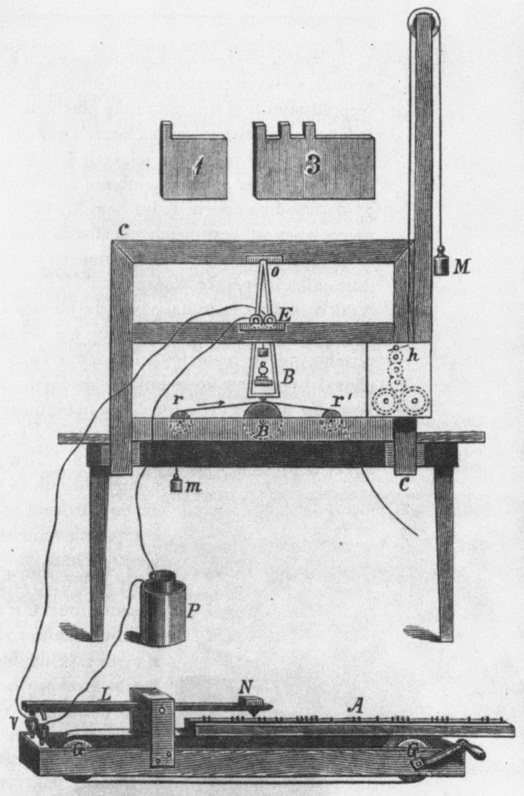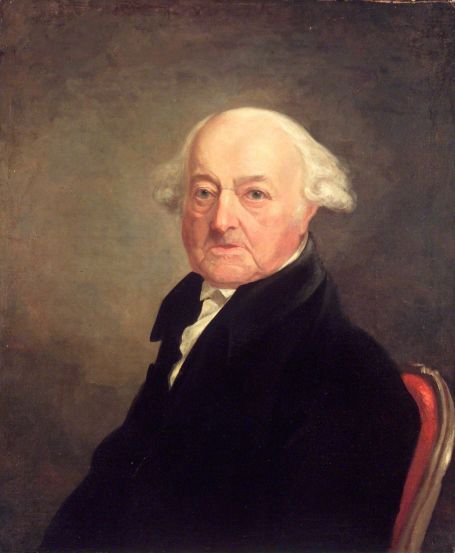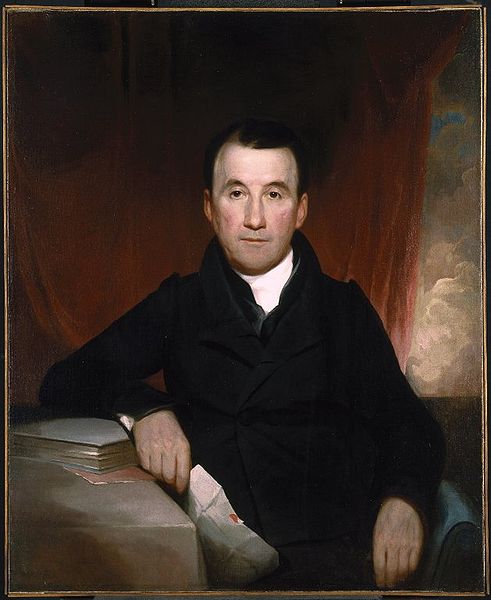<Back to Index>
- Inventor Samuel Finley Breese Morse, 1791
- Composer Sergei Sergeyevich Prokofiev, 1891
- Queen Consort of Spain Maria Christina of the Two Sicilies, 1806
PAGE SPONSOR
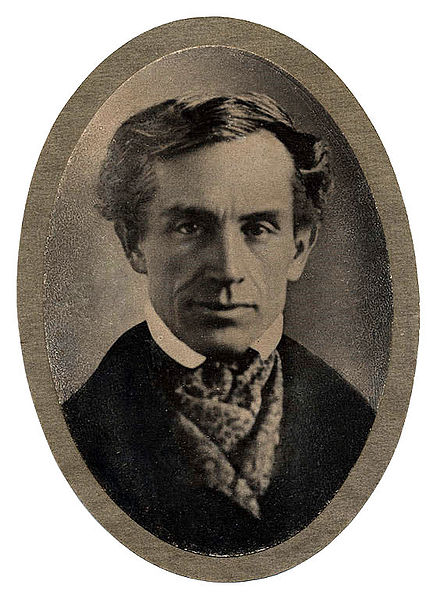
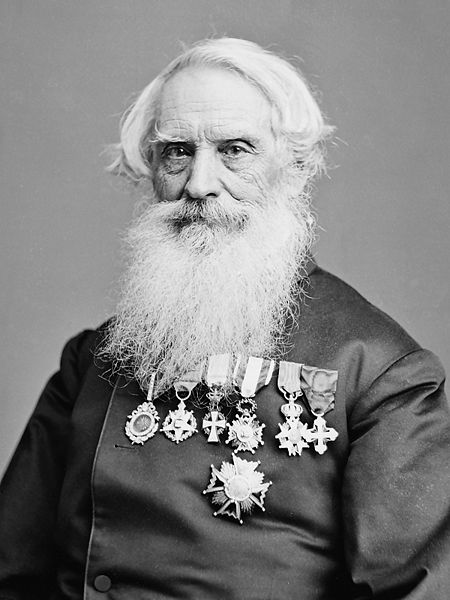
Samuel Finley Breese Morse (27 April 1791 – 2 April 1872) was an American contributor to the invention of a single-wire telegraph system based on European telegraphs, co-inventor of the Morse code, and an accomplished painter.
Samuel F.B. Morse was born in Charlestown, Massachusetts, the first child of a geographer and Pastor Jedidiah Morse (1761 – 1826) and Elizabeth Ann Finley Breese (1766 – 1828). Jedidiah was a great preacher of the Calvinist faith and supporter of the American Federalist party. He not only saw it as a great preserver of Puritan traditions (strict observance of the Sabbath), but believed in its idea of an alliance with Britain in regards to a strong central government. Jedidiah strongly believed in education within a Federalist framework alongside the instillation of Calvinist virtues, morals and prayers for his son. After attending Phillips Academy in Andover, Massachusetts, Samuel Morse went on to Yale College to receive instruction in the subjects of religious philosophy, mathematics and science of horses. While at Yale, he attended lectures on electricity from Benjamin Silliman and Jeremiah Day. He supported himself financially by painting. In 1810, he graduated from Yale with Phi Beta Kappa honors.
Morse's Calvinist beliefs are evident in his painting the Landing of the Pilgrims, through the depiction of simple clothing as well as the austere facial features. This image captured the psychology of the Federalists; Calvinists from England brought to the United States ideas of religion and government thus forever linking the two countries. More importantly, this particular work attracted the attention of the famous artist, Washington Allston. Allston wanted Morse to accompany him to England to meet the artist Benjamin West. An agreement for a three-year stay was made with Jedidiah, and young Morse set sail with Allston aboard the Lydia on July 15, 1811.
Upon his
arrival in England, Morse diligently worked to perfect painting
techniques under Allston's watchful eye; by the end of 1811, he gained admittance to the Royal
Academy. At the Academy, he fell in love with the Neo-classical art of the Renaissance and paid close attention to Michelangelo and Raphael.
After
observing and practicing life
drawing and
absorbing its anatomical demands, the young artist successfully
produced his masterpiece, the Dying
Hercules. To some,
the Dying Hercules seemed to represent a
political statement against the British and also the American
Federalists. The muscles apparently symbolized the strength of the
young and vibrant United States versus the British and British-American
supporters. During Morse’s time in Britain the Americans and British
were engaged in the War
of
1812 and
division existed within United States society over loyalties.
Anti-Federalist Americans aligned themselves with the French, abhorred
the British, and believed a strong central government to be inherently
dangerous to democracy. As the war raged on, his letters to his
parents became more anti-Federalist in tone. In one such letter Morse
said, "I assert that the Federalists in the Northern States have done
more injury to their country by their violent opposition measures than
a French alliance could. Their proceedings are copied into the English
papers, read before Parliament,
and circulated through their country, and what do they say of them...
they call them (Federalists) cowards, a base set, say they are traitors to their country and ought to be hanged like traitors." Although
Jedidiah did not change his political views, he did influence Morse’s
in another way. It is unmistakably clear that Jedidiah’s Calvinist
ideas were an integral part of Morse’s other significant English piece Judgment of Jupiter. Jupiter in the cloud, accompanied
by his eagle,
with
his hand over the parties, is pronouncing judgment. Marpessa with an expression of
compunction and shame, imploring forgiveness, is throwing herself into
the arms of her husband. Idas, who tenderly loved Marpessa, is eagerly
rushing forward to receive her, while Apollo stares
with
surprise… at the unexpectedness of her decision...
A case
can be made that Jupiter is representative of God’s
omnipotence watching every move that is made. One might deem the
portrait as a moral teaching by Morse on infidelity.
Although
Marpessa fell victim she realized that her eternal
salvation was
important and desisted from her wicked ways. Apollo shows no remorse
for what he did, but just stands there with a puzzled look. A lot of
the American paintings throughout the early nineteenth century had
religious themes and tones and it was Morse who was the forerunner. Judgment of Jupiter allowed Mr. Morse to
express his support of Anti Federalism while maintaining his strong
spiritual convictions. This work represented American nationalism
through Calvinism because these individuals expelled from England,
contributed to the expulsion of the British (1776 and now in 1812) and
established a free democratic society. West sought to present this
image at another Royal Academy exhibition; unfortunately his time had
run out. He left England on August 21, 1815 and began his full-time
career as an American painter. The years
1815 – 1825 marked significant growth in Morse’s paintings as he sought
to capture the essence of America’s culture and life. He had the honor
of painting former Federalist President John
Adams (1816). He
hoped to become part of grander projects and saw his opportunity with
the clash between Federalist and Anti-Federalists over Dartmouth
College. Morse was able to paint Judge Woodward (1817) who was
involved in bringing the
Dartmouth
case before
the U.S.
Supreme
Court and
the college’s president, Francis
Brown. He sought commissions in Charleston,
South
Carolina (1818).
Morse’s painting of Mrs. Emma Quash symbolized the opulence of
Charleston. It seemed for the time being, the young artist was doing
well for himself. Between
1819 and 1821, Morse experienced a great change in his life. Nothing
stayed the same after that. Commissions ceased in Charleston when the
city was hit with an economic recession related to the Panic
of
1819. Jedidiah was forced to resign from his ministerial position as he was unsuccessful in stopping the rift within Calvinism.
The new branch that formed was the Congregational Unitarians which he
deemed as detestable anti-Federalists because these persons took a
different approach over salvation. Although he respected his father’s
religious opinions, he sympathized with the Unitarians.
A
prominent family that converted to the new Calvinist faith was the
Pickerings of Portsmouth whom Morse had painted. This portrait can then
be viewed as a further shift towards anti-Federalism. A person could
argue that he made his full transition to anti-Federalism when he was
commissioned to paint President James
Monroe (1820). Monroe embodied Jeffersonian Democracy by favoring the common man over
the aristocrat; later reemphasized upon the ascension of Andrew Jackson. There
were two defining commissions that shaped Morse’s art career from his
return to New
Haven until the
establishment of the National Academy
of Design. The Hall of Congress (1821) and the Marquis
de
Lafayette (1825)
engaged Morse’s sense of democratic nationalism. The Hall of Congress
was designed to capitalize on the astonishing success of
François-Marius Granet's The
Capuchin
Chapel in Rome which
toured
the United States extensively throughout the 1820s, attracting
audiences willing to pay the 25-cent admission fee. The artist chose to paint
the House
of
Representatives, in a similar way, with careful attention to
architecture and dramatic lighting. He also wished to select a uniquely
American topic that would bring glory to the young nation, and his
topic did just that, showing American democracy in action. He traveled
to Washington
D.C. to draw the
architecture of the new halls, carefully placing eighty individuals
within the painting and believed that a night scene was appropriate. He
successfully balanced the architecture of the Rotunda with the
figurines and the glow of the lamplight serving as the focal point of
the work. Pairs of people, those who stood alone, individuals bent over
their desks working were painted simply but had characterized faces.
Morse chose nighttime to convey Congress’ dedication to the principles
of democracy transcended day. The Hall of Congress however, failed to
draw a crowd in New
York
City. One possible reason for the disappointment was the
shadow of John Trumbull’s Declaration of Independence that won popular
acclaim in 1820. A second explanation is that the overwhelming
attention to the architecture of the Hall of Congress overshadows the
individuals, making it hard to appreciate the drama of what was
actually happening. Morse
felt a great degree of honor of painting the Marquis
de
Lafayette, leading supporter of the American
Revolution. He felt compelled to paint a grandiose portrait of the
man who helped to establish a free and independent America. In his
image, he enshrouds Lafayette with a magnificent sunset as he stands to
the right of three pedestals of which two are Benjamin
Franklin and George
Washington with the final reserved for him. A peaceful wooden
landscape below him symbolized American tranquility and prosperity as
it approach the age of fifty. The developing friendship between Morse
and Lafayette and the discussion of the Revolutionary War, affected the
artist upon returning to New York City. Morse was
in Europe for three years improving
his painting skills, 1830 – 1832, travelling in Italy, Switzerland and France.
The
project he eventually selected was to paint miniature copies of
some 38 of the Louvre's
famous
paintings on a single canvas (6 ft. x 9 ft) which he
entitled The Gallery
of the Louvre, planning to complete the work upon his return to the
United States. On a subsequent visit to Paris in 1839, Morse met Louis
Daguerre and became
interested in the latter's daguerreotype,
the
first practical means of photography.
Morse
wrote a letter to the New-York
Observer describing
the invention, which was published widely in the American press and
provided a broad awareness. In 1825,
the city of New
York commissioned
Morse for $1,000 to paint a portrait of Gilbert
du
Motier, marquis de Lafayette, in Washington. In the midst of
painting, a horse messenger delivered a letter from his father that
read one line, "Your dear wife is convalescent". Morse immediately left
Washington for his home at New
Haven, leaving the portrait of Lafayette unfinished. By the time he arrived she had already been buried. Heartbroken in the
knowledge that for days he was unaware of his wife's failing health and
her lonely death, he moved on from painting to pursue a means of rapid long
distance
communication. On the
sea voyage home in 1832, Morse encountered Charles
Thomas
Jackson of Boston who was well schooled in electromagnetism. Witnessing
various experiments with Jackson's electromagnet,
Morse
developed the concept of a single-wire telegraph,
and The Gallery of the Louvre was set
aside. The original Morse telegraph, submitted with his patent application, is part of the
collections of the National
Museum of American History at
the Smithsonian
Institution. In time the Morse
code would become
the primary language of telegraphy in the world, and is still the
standard for rhythmic transmission of data. William
Cooke and Professor Charles
Wheatstone learned
of the Wilhelm
Weber and Carl
Gauß electromagnetic
telegraph
in 1833, and reached the stage of launching a commercial
telegraph prior to Morse, despite starting later. In England, Cooke
became fascinated by electrical telegraph in 1836, four years after
Morse, but with greater financial resources. Cooke abandoned his
primary subject of anatomy and built a small
electrical telegraph within three weeks. Wheatstone also was
experimenting with telegraphy and (most importantly) understood that a
single large battery would not carry a
telegraphic signal over long distances, and that numerous small
batteries were far more successful and efficient in this task
(Wheatstone was building on the primary research of Joseph
Henry, an American physicist).
Cooke
and Wheatstone formed a partnership and patented the electrical
telegraph in May 1837, and within a short time had provided the Great
Western
Railway with
a 13-mile (21 km) stretch of telegraph. However, Cooke and
Wheatstone's multiple wire signaling method would be overtaken by
Morse's superior method within a few years. In a
letter to a friend, Morse describes how vigorously he fought for being
called the sole inventor of the electromagnetic telegraph despite the previous
inventions (1848). Morse
encountered the problem of getting a telegraphic signal to carry over
more than a few hundred yards of wire. His breakthrough came from the
insights of Professor Leonard Gale, who taught chemistry at New
York
University (a
personal friend of Joseph
Henry). With Gale's help, Morse soon was able to send a message
through ten miles (16 km) of wire. This was the great breakthrough
Morse had been seeking. Morse and Gale were soon joined by a young
enthusiastic man, Alfred
Vail, who had excellent skills, insights and money. Morse's
telegraph now began to be developed very rapidly. In 1838 a
trip to Washington,
D.C., failed to attract federal sponsorship for a telegraph line.
Morse then traveled to Europe seeking both sponsorship and patents, but
in London discovered Cooke and Wheatstone had already established
priority. Morse would need the financial backing of Maine congressman Francis
Ormand
Jonathan Smith. Morse
made one last trip to Washington, D.C., in December 1842, stringing
"wires between two committee rooms in the Capitol, and sent messages
back and forth" to demonstrate his telegraph system. Congress
appropriated $30,000 in 1843 for construction of an experimental
38-mile (61 km) telegraph line between Washington, D.C., and Baltimore,
Maryland, along the right-of-way of the Baltimore
and Ohio Railroad. An impressive demonstration
occurred on May 1, 1844, when news of the Whig
Party's nomination of Henry
Clay for U.S. President was telegraphed from the party's convention in Baltimore to
the Capitol Building in Washington.
On
May 24, 1844, the line was officially opened as Morse sent the
famous words "What
hath
God wrought" from the B&O's Mount
Clare
Station in
Baltimore to the Capitol Building along the wire. Annie Ellsworth chose these
words from the Bible (Numbers 23:23); her father, U.S.
Patent
Commissioner Henry
Leavitt
Ellsworth, had championed Morse's invention and secured
early funding for it. In May
1845 the Magnetic Telegraph Company was formed in order to radiate
telegraph lines from New
York
City towards Philadelphia, Boston, Buffalo,
New
York and the Mississippi. Morse
also at one time adopted Wheatstone and Carl
August
von Steinheil's idea of broadcasting an electrical telegraph
signal through a body of water or down steel railroad tracks or
anything conductive. He went to great lengths to win a law suit for the right to be called
"inventor of the telegraph", and promoted himself as being an inventor,
but Alfred
Vail played an
important role in the invention of the Morse Code, which was based on earlier codes for the electromagnetic
telegraph. Samuel
Morse received a patent for the telegraph in 1847, at the old
Beylerbeyi Palace (the present Beylerbeyi
Palace was built in
1861 – 1865 on the same location) in Istanbul,
which
was issued by Sultan
Abdülmecid who
personally tested the new invention. In the
1850s, Morse went to Copenhagen and visited the Thorvaldsens
Museum, where the sculptor's grave is in the inner courtyard. He
was received by King
Frederick
VII, who decorated him with the Order
of
the Dannebrog. Morse expressed his wish to donate his portrait
from 1830 to the king. The Thorvaldsen portrait today belongs to Margaret
II
of Denmark. The Morse
telegraphic apparatus was officially adopted as the standard for
European telegraphy in 1851. Only the United
Kingdom (with its extensive overseas British
Empire) kept the needle telegraph of Cooke and Wheatstone. There is
an argument amongst historians that Morse may have received the idea of
a plausible telegraph from Harrison
Gray
Dyar some
eighteen years earlier than his patent. According
to his The New York
Times obituary
published on April 3, 1872, Morse received respectively the decoration
of the Atiq
Nishan-i-Iftikhar (English:
Order
of Glory), set in diamonds, from the Sultan
Ahmad
I ibn Mustafa of Turkey (c.1847),
a golden snuff box
containing the Prussian gold medal for scientific merit from the King of Prussia
(1851); the Great
Gold Medal of Arts and Sciences from
the King
of
Württemberg (1852);
and
the Great Golden
Medal of Science and Arts from Emperor
of
Austria (1855);
a cross of Chevalier in the Légion
d'honneur from the
Emperor of France; the Cross
of
a Knight of the Order
of
the Dannebrog from
the King of Denmark (1856); the Cross of Knight Commander of the Order
of
Isabella the Catholic, from the Queen of Spain, besides being
elected member of innumerable scientific and art societies in the United States and other countries. Other awards include Order
of
the Tower and Sword from the
kingdom of Portugal (1860); and Italy conferred on him the insignia
of chevalier of the Order
of
Saints Maurice and Lazarus in
1864. In the
United States, Morse had his telegraph patent for many years, but it
was both ignored and contested. In 1853 the
case
of the patent came
before the U.S.
Supreme
Court where,
after very lengthy investigation, Chief
Justice Roger
B.
Taney ruled that
Morse had been the first to combine the battery, electromagnetism,
the electromagnet and the correct battery
configuration into a workable practical telegraph. Nevertheless, in
spite of this clear ruling, Morse still received no official
recognition from the United
States
government. Assisted
by the American
ambassador in
Paris, the governments of Europe were approached regarding how they had
long neglected Morse while using his invention. There was then a
widespread recognition that something must be done, and "in 1858 Morse
was awarded the sum of 400,000 French
francs (equivalent
to about $80,000 at the time) by the governments of France, Austria, Belgium,
the Netherlands, Piedmont, Russia, Sweden, Tuscany and Turkey,
each
of which contributed a share according to the number of Morse
instruments in use in each country." In 1858, he was also elected a
foreign member of the Royal
Swedish
Academy of Sciences. There was
still no such recognition in the U.S. This remained the case until June
10, 1871, when a bronze statue of Samuel Morse was unveiled in Central
Park, New
York
City. An engraved portrait of Morse appeared on the reverse
side of the United
States
two-dollar bill silver certificate series
of 1896. He was depicted along with Robert
Fulton. An example can be seen on the website of the Federal
Reserve Bank of San Francisco's website in their "American Currency
Exhibit". A blue
plaque was erected
to commemorate him at 141 Cleveland Street, London,
where
he lived from 1812 to 1815. In
addition to the telegraph, Morse invented a marble-cutting machine that could carve three
dimensional sculptures in marble or stone. Morse couldn't patent it, however, because of an existing 1820 Thomas
Blanchard design. In the
1850s, Morse became well known as a defender of America's institution of slavery,
considering
it to be sanctioned. In his treatise "An Argument on the
Ethical Position of Slavery," he wrote: My
creed on the subject of slavery is short. Slavery per se is not sin. It
is a social condition ordained from the beginning of the world for the
wisest purposes, benevolent and disciplinary, by Divine Wisdom. The
mere holding of slaves, therefore, is a condition having per se nothing
of moral character in it, any more than the being a parent, or
employer, or ruler. Samuel
Morse was a generous man who gave large sums to charity. He also became
interested in the relationship of science and religion and provided the
funds to establish a lectureship on 'the relation of the Bible to the
Sciences'. Morse was not a selfish man. Other people and corporations
made millions using his inventions, yet most rarely paid him for the
use of his patented telegraph. He was not bitter about this, though he
would have appreciated more rewards for his labors. Morse was
comfortable; by the time of his death, his estate was valued at some
$500,000.
Morse
died
on April 2, 1872, 25 days short of his 81st birthday. He died of pneumonia.
He
was at his home at 5 West 22nd Street, New
York City, at the age of 80, and was buried in the Green-Wood
Cemetery in Brooklyn,
New
York. Morse was
a leader in the anti-Catholic and anti-immigration
movement of the mid-19th century. In 1836, he ran unsuccessfully for mayor of
New York under
the anti-immigrant Nativist
Party's banner, receiving only 1496 votes. When Morse visited Rome,
he
refused to take his hat off in the presence of the Pope.
Upon
seeing this, an offended Swiss
Guardsman rushed
over and hit the hat off of his head. Morse worked to unite Protestants
against Catholic institutions (including schools), wanted to forbid
Catholics from holding public office, and promoted changing immigration
laws to limit immigration from Catholic countries. On this topic, he
wrote, “We must first stop the leak in the ship through which muddy
waters from without threaten to sink us.” Morse was
the author of a number of letters to the New York Observer (his brother Sidney was the
editor at the time) urging people to fight the perceived Catholic
menace. These articles were widely reprinted in other newspapers. Among
other claims, he believed that the Austrian
government and
Catholic aid organizations were subsidizing Catholic immigration to the
United States in order to gain control of the country. In his Conspiracy Against the
Liberties of the United States, Morse wrote: “Surely American
Protestants, freemen, have discernment enough to discover beneath them
the cloven foot of this subtle foreign heresy. They will see that Popery is now, what it has ever
been, a system of the darkest political intrigue and despotism,
cloaking itself to avoid attack under the sacred name of religion. They
will be deeply impressed with the truth, that Popery is a political as
well as a religious system; that in this respect it differs totally
from all other sects, from all other forms
of
religion in the country.”
